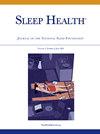2012年至2022年间,法国发放报销催眠药的国家趋势的描述性研究。
IF 3.4
2区 医学
Q2 CLINICAL NEUROLOGY
引用次数: 0
摘要
目的:失眠和催眠消费是主要的公共卫生问题,特别是由于依赖性、副作用和滥用问题。本研究旨在描述2012年至2022年法国报销催眠片的配药趋势,强调以减少苯二氮卓类药物和z类药物处方为主的公共政策的潜在影响。方法:数据来源于Medic’am数据库,由法国国民健康保险管理,该数据库记录了药店提供的所有报销药物的数量。该研究重点研究了13种在法国获得特定上市许可的失眠药物,包括z-药物(唑吡坦、佐匹克隆)、抗组胺药(alimemazine、doxylamine、chlorazsampate +acepromazine、meprobamate+acepromazine)和苯二氮卓类药物(lormetazepam、loprazolam、estazolam、nitrazepam、temazepam、triazolam、氟硝西泮)。结果:在11年的时间里,随着公共卫生政策的实施,可报销的配药片减少了25.30%。z类药物下降了39.54%,主要原因是在要求使用安全处方垫后,唑吡坦的处方减少了69.15%。其他抗组胺类药物撤市后,以alimemazine为代表的抗组胺类药物下降5.48%。在氟硝西泮、替马西泮和硝西泮停药或退市后,苯二氮卓类药物减少了16.98%,主要以氯美西泮和氯吡唑仑为代表。从比例上看,抗组胺药的使用减少,而苯二氮卓类药物的使用保持相对稳定。在2019冠状病毒病大流行及其封锁期间,处方催眠药的减少幅度较小。结论:分析这些趋势可以深入了解同步公共卫生政策的潜在影响。虽然这些趋势是有希望的,但需要继续努力,强调预防和非药物措施,包括改善睡眠卫生。本文章由计算机程序翻译,如有差异,请以英文原文为准。
A descriptive study of national trends in the dispensing of reimbursed hypnotics in France between 2012 and 2022
Objectives
Insomnia and hypnotic consumption are major public health concerns, especially due to issues of dependence, side effects, and misuse. This study aims to describe the dispensing trends of reimbursed hypnotic tablets in France from 2012 to 2022, highlighting the potential impact of public policies designed to mainly reduce prescriptions of benzodiazepines and z-drugs.
Methods
Data were sourced from the Medic'AM database, managed by French National Health Insurance, which records quantities of all reimbursed medications provided by pharmacies. The study focused on 13 reimbursed hypnotics with specific French marketing authorization for insomnia, including z-drugs (zolpidem, zopiclone), antihistamines (alimemazine, doxylamine, chlorazépate+acepromazine, meprobamate+acepromazine), and benzodiazepines (lormetazepam, loprazolam, estazolam, nitrazepam, temazepam, triazolam, flunitrazepam).
Results
Over the 11-year period, alongside public health policies, a 25.30% decrease in reimbursed dispensed tablets was observed. Z-drugs saw a major 39.54% decrease, primarily due to a 69.15% drop in zolpidem prescriptions following the requirement for secure prescription pads. Antihistamines, mainly represented by alimemazine after the withdrawal and delisting of other antihistaminergic specialties, decreased by 5.48%. Benzodiazepines experienced a 16.98% reduction, mainly represented by lormetazepam and loprazolam, following the withdrawal or delisting of flunitrazepam, temazepam, and nitrazepam. Proportionally, the use of z-drugs decreased in favor of antihistamines, while benzodiazepines remained relatively stable. During the COVID-19 pandemic and its lockdowns, there was a smaller reduction in dispensed hypnotics.
Conclusions
Analyzing these trends provides insights into the potential impact of concurrent public health policies. While these trends are promising, continued efforts are necessary, emphasizing preventive and nonpharmacological measures, including improved sleep hygiene.
求助全文
通过发布文献求助,成功后即可免费获取论文全文。
去求助
来源期刊

Sleep Health
CLINICAL NEUROLOGY-
CiteScore
6.30
自引率
9.80%
发文量
114
审稿时长
54 days
期刊介绍:
Sleep Health Journal of the National Sleep Foundation is a multidisciplinary journal that explores sleep''s role in population health and elucidates the social science perspective on sleep and health. Aligned with the National Sleep Foundation''s global authoritative, evidence-based voice for sleep health, the journal serves as the foremost publication for manuscripts that advance the sleep health of all members of society.The scope of the journal extends across diverse sleep-related fields, including anthropology, education, health services research, human development, international health, law, mental health, nursing, nutrition, psychology, public health, public policy, fatigue management, transportation, social work, and sociology. The journal welcomes original research articles, review articles, brief reports, special articles, letters to the editor, editorials, and commentaries.
 求助内容:
求助内容: 应助结果提醒方式:
应助结果提醒方式:


